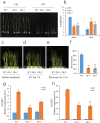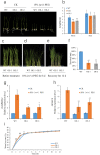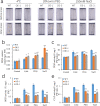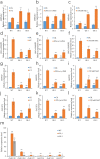OsSCL30 overexpression reduces the tolerance of rice seedlings to low temperature, drought and salt
- PMID: 35589923
- PMCID: PMC9120446
- DOI: 10.1038/s41598-022-12438-4
OsSCL30 overexpression reduces the tolerance of rice seedlings to low temperature, drought and salt
Abstract
Rice is one of the main food crops for the world population. Various abiotic stresses, such as low temperature, drought, and high salinity, affect rice during the entire growth period, determining its yield and quality, and even leading to plant death. In this study, by constructing overexpression vectors D-163 + 1300:OsSCL30 and D-163 + 1300-AcGFP:OsSCL30-GFP, the mechanism of action of OsSCL30 in various abiotic stresses was explored. Bioinformatics analysis showed that OsSCL30 was located on the chromosome 12 of rice Nipponbare, belonging to the plant-specific SCL subfamily of the SR protein family. The 1500 bp section upstream of the open reading frame start site contains stress-related cis-acting elements such as ABRE, MYC, and MYB. Under normal conditions, the expression of OsSCL30 was higher in leaves and leaf sheaths. The results of reverse transcription polymerase chain reaction showed that the expression of OsSCL30 decreased after low temperature, drought and salt treatment. In root cells OsSCL30 was localized in the nuclei. The results of the rice seedling tolerance and recovery tests showed that overexpression of OsSCL30 diminished the resistance to low temperature, drought and salt stresses in transgenic rice and resulted in larger accumulation of reactive oxygen species. This study is of great significance for exploring the response mechanisms of SR proteins under abiotic stresses.
© 2022. The Author(s).
Conflict of interest statement
The authors declare no competing interests.
Figures








Similar articles
-
Wheat TaTIP4;1 Confers Enhanced Tolerance to Drought, Salt and Osmotic Stress in Arabidopsis and Rice.Int J Mol Sci. 2022 Feb 14;23(4):2085. doi: 10.3390/ijms23042085. Int J Mol Sci. 2022. PMID: 35216200 Free PMC article.
-
Overexpression of OsEm1 encoding a group I LEA protein confers enhanced drought tolerance in rice.Biochem Biophys Res Commun. 2016 Sep 16;478(2):703-9. doi: 10.1016/j.bbrc.2016.08.010. Epub 2016 Aug 11. Biochem Biophys Res Commun. 2016. PMID: 27524243
-
Physiological mechanisms underlying OsNAC5-dependent tolerance of rice plants to abiotic stress.Planta. 2011 Aug;234(2):331-45. doi: 10.1007/s00425-011-1403-2. Epub 2011 Mar 30. Planta. 2011. PMID: 21448719
-
Rice Responses to Abiotic Stress: Key Proteins and Molecular Mechanisms.Int J Mol Sci. 2025 Jan 22;26(3):896. doi: 10.3390/ijms26030896. Int J Mol Sci. 2025. PMID: 39940666 Free PMC article. Review.
-
Research progress of peptides discovery and function in resistance to abiotic stress in plant.Stress Biol. 2025 May 23;5(1):36. doi: 10.1007/s44154-025-00220-1. Stress Biol. 2025. PMID: 40407840 Free PMC article. Review.
Cited by
-
Comprehensive study of serine/arginine-rich (SR) gene family in rice: characterization, evolution and expression analysis.PeerJ. 2023 Oct 13;11:e16193. doi: 10.7717/peerj.16193. eCollection 2023. PeerJ. 2023. PMID: 37849832 Free PMC article.
-
Knocking Out the Transcription Factor OsNAC092 Promoted Rice Drought Tolerance.Biology (Basel). 2022 Dec 15;11(12):1830. doi: 10.3390/biology11121830. Biology (Basel). 2022. PMID: 36552339 Free PMC article.
-
Genome-Scale Identification of Wild Soybean Serine/Arginine-Rich Protein Family Genes and Their Responses to Abiotic Stresses.Int J Mol Sci. 2024 Oct 17;25(20):11175. doi: 10.3390/ijms252011175. Int J Mol Sci. 2024. PMID: 39456959 Free PMC article.
-
Identification of the RRM1 gene family in rice (Oryza sativa) and its response to rice blast.PeerJ. 2024 Jul 26;12:e17668. doi: 10.7717/peerj.17668. eCollection 2024. PeerJ. 2024. PMID: 39076776 Free PMC article.
-
Meta-analysis of plant growth-promoting rhizobacteria interaction with host plants: implications for drought stress response gene expression.Front Plant Sci. 2024 Jan 15;14:1282553. doi: 10.3389/fpls.2023.1282553. eCollection 2023. Front Plant Sci. 2024. PMID: 38288406 Free PMC article.
References
Publication types
MeSH terms
Substances
LinkOut - more resources
Full Text Sources
Research Materials
Miscellaneous

